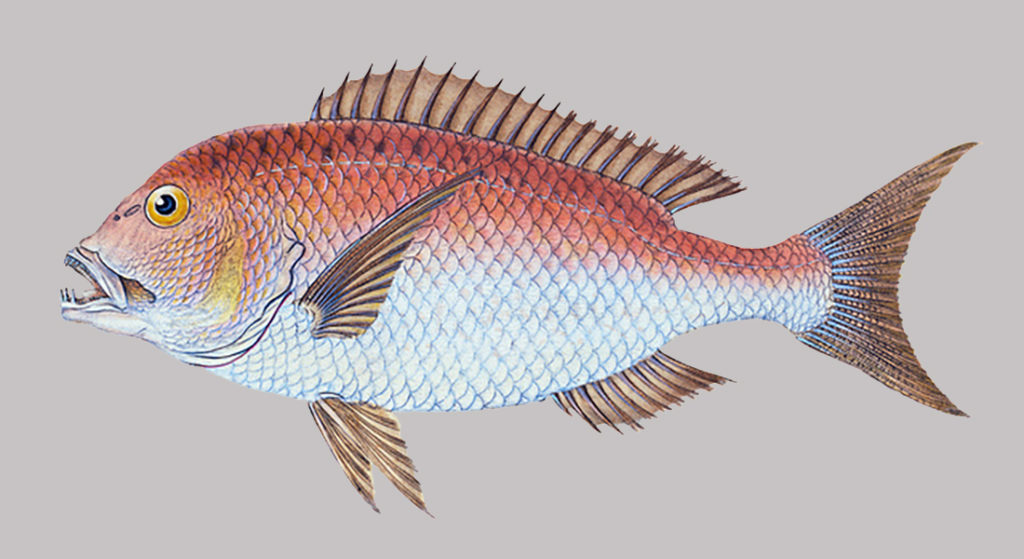There may be concerns with genetically modified organisms (GMO), but the effectiveness of gene editing in developing more productive plants and animals for the agriculture industry can not be argued. With the rise of cheap and simple gene editing technologies, more and more breeds of animals and plants are being bred and raised with edited genetic code.
Researchers at Kyoto University in Japan and other affiliated institutions have recently created a genetically modified red sea bream (Pagrus major). Red sea bream is a high-value fish that is found in the north Pacific sea and is consumed widely, especially at events like weddings and festivals, in Korea, Taiwan, and Japan. It is one of the most important aquaculture species in Japan based on the production amount and value. These fish are GMO, but they are not transgenic – some of their own DNA has been deleted but they have not had genes from any other species added to their genome.
Before genetic modification, farmers would have to breed animals for many generations to get the offspring with the desired trait. This process is very slow, because it requires waiting until gene mutations occur naturally. Plant and animal breeders attempt to speed this up by exposing the organisms to radiation, which increases mutations, and thus the likelihood of the “right” mutation.
For red sea bream, the researchers wanted to create a fish without the gene for myostatin, a hormone that limits muscle mass. Animals without myostatin have more muscle and less fat. Fish with more muscle will yield a larger fillet, and will therefore be more desirable at the market.
Getting red sea bream without the myostatin gene was accomplished with a relatively new and inexpensive genetic engineering technology called CRISPR. In nature, CRISPR is a basic form of an acquired immune system found in bacteria. It keeps records of foreign DNA from viruses it encounters and when it encounters that DNA again, it binds to the foreign DNA and cuts it, preventing the virus from hurting the bacteria. CRISPR is commonly used in genome editing to bind to a specific spot in the genome and cut the DNA. Then a new section is inserted or an existing section is deleted and the DNA is repaired.

Image Source: https://flic.kr/p/dRgb8N
In nature, this repair mechanism can often result in errors, such as insertions or deletions, so the change made by the researchers could theoretically occur in nature. And it has – there are 2 breeds of cows, Belgian Blue and Piedmontese (pictured above) that naturally carry this mutation and thus look “bulked up,” due to the extra muscle they produce. In this study, they just programmed the fish to make a specific error – a deletion of a section in a specific place.
Changing the genetic code of an animal starts with the very first cell, the egg. The CRISPR technique is performed on fertilized eggs soon after fertilization, before the first DNA replication. Editing the DNA at this time means the change should be present in all of the cells in the animal as it develops, but this is not always the case. So when the CRISPR-edited fish were about 6 months old, they sequenced DNA from the caudal fin to determine the level of mutation in the individual: “high”, “low” or “none”.
Next they bred the fish with a “high” mutation level with wild red sea bream to see what percentage of offspring would inherit the mutation. Then they mated the highly mutated fish that survived to sexual maturity together. The offspring that inherited edited myostatin genes from both parents were then mated together to create a whole generation of fish that had no myostatin. These fish could be bred together to create 100% myostatin-free fish in the next generation as well. Traditional breeding takes many generations to achieve 100% of a desired trait, but CRISPR editing combined with DNA sequencing to identify animals with the desired mutation achieved this in only three generations.
The study was a success. The mutated fish had the same body weight as non-edited fish, however they produced 16% more muscle and their body length was shorter on average. There were no skeletal deformities in the edited fish, indicating that the shorter length was not harmful to the fish.
The researchers have considered the ethics of their research in every step. To avoid potentially contaminating wild fish with edited genes, they grew all of the modified fish in inland tanks. They also looked for any unintentional changes to the genome and did not find any. From this, they concluded that the shortened body length was caused by the lack of myostatin and is not an accidental DNA change.
Increasing the amount of skeletal muscle in an animal leads to an increase in food for people and reduces the waste from processing, which are beneficial outcomes for both consumers and producers. As long as wild organisms are not impacted by GM organisms, genetic modification could be an answer to a lot of current problems in agriculture and aquaculture.


